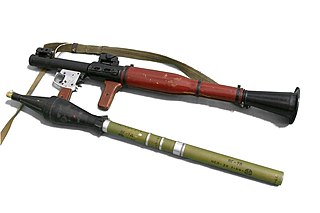
A rocket-propelled grenade (RPG) is a shoulder-fired rocket weapon that launches rockets equipped with an explosive warhead. Most RPGs can be carried by an individual soldier, and are frequently used as anti-tank weapons. These warheads are affixed to a rocket motor which propels the RPG towards the target and they are stabilized in flight with fins. Some types of RPG are reloadable with new rocket-propelled grenades, while others are single-use. RPGs are generally loaded from the front.

A tank is an armoured fighting vehicle intended as a primary offensive weapon in front-line ground combat. Tank designs are a balance of heavy firepower, strong armour, and battlefield mobility provided by tracks and a powerful engine; their main armament is often mounted within a turret. They are a mainstay of modern 20th and 21st century ground forces and a key part of combined arms combat.
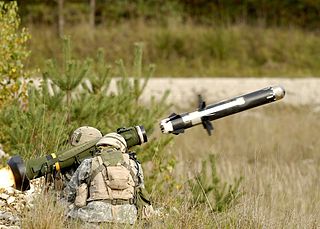
An anti-tank guided missile (ATGM), anti-tank missile, anti-tank guided weapon (ATGW) or anti-armor guided weapon is a guided missile primarily designed to hit and destroy heavily armored military vehicles. ATGMs range in size from shoulder-launched weapons, which can be transported by a single soldier, to larger tripod-mounted weapons, which require a squad or team to transport and fire, to vehicle and aircraft mounted missile systems.
Semi-automatic command to line of sight (SACLOS) is a method of missile command guidance. In SACLOS, the operator must continually point a sighting device at the target while the missile is in flight. Electronics in the sighting device and/or the missile then guide it to the target.

The T-90 is a third-generation Russian main battle tank developed to replace the T-72. It uses a 125 mm 2A46 smoothbore main gun, the 1A45T fire-control system, an upgraded engine, and gunner's thermal sight. Standard protective measures include a blend of steel and composite armour, smoke grenade dischargers, Kontakt-5 explosive reactive armour (ERA) and the Shtora infrared anti-tank guided missile (ATGM) jamming system.
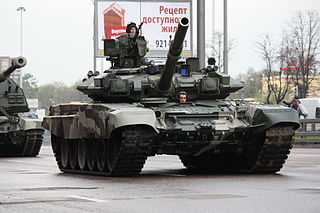
Shtora-1 is an electro-optical active protection system or suite for tanks, designed to disrupt the laser designator and laser rangefinders of incoming anti-tank guided missiles (ATGMs). The system is mounted on the Russian T-80 and T-90 series tanks and the Ukrainian T-84. The existence of Shtora was revealed in 1980 by spy Adolf Tolkachev.

Arena is an active protection system (APS) developed at Russia's Kolomna-based Engineering Design Bureau for the purpose of protecting armoured fighting vehicles from destruction by light anti-tank weapons, anti-tank guided missiles (ATGM), and flyover top attack missiles. It uses a Doppler radar to detect incoming warheads. Upon detection, a defensive rocket is fired that detonates near the inbound threat, destroying it before it hits the vehicle.

The 9M120 Ataka is an anti-tank guided missile (ATGM) originating from the Soviet Union. The NATO reporting name of the 9M120 missile is the AT-9 Spiral-2. It is the next major generation in the 9K114 Shturm family. The missile has radio command guidance and is also a beam riding SACLOS. This missile's primary variant was designed to defeat tanks with composite armour and explosive reactive armor. The 9M120 Ataka system is often confused with the 9K121 Vikhr system, despite being different weapons systems developed by different companies. The former was designed by the KBM machine-building design bureau and manufactured by the Degtyarev plant. According to the Stockholm International Peace Research Institute, Russia exported the Ataka ATGM to Iran, Kazakhstan, and Slovenia.

Trophy is a military armored vehicle active protection system (APS) designed by Rafael Advanced Defense Systems.

The 9M123 Khrizantema is a Russian anti-tank guided missile (ATGM). Khrizantema was designed to deal with current and future generations of main battle tanks and can also be used to engage slow and low flying aerial targets like helicopters. The 9M123 missile, and its associated guidance system, forms the 9K123 missile system.

Iron Fist is a hard-kill active protection system (APS) designed by Israel Military Industries (IMI), with a modular design allowing adaptation to a range of platforms ranging from light utility vehicles to heavy armoured fighting vehicles. The concept was revealed by IMI in 2006 and was expected to enter Israel Defense Forces tests by mid-2007. The system has been successfully tested against a wide variety of threats including rocket-propelled grenades, anti-tank guided missiles and tank-fired high-explosive anti-tank (HEAT) ammunition and kinetic energy penetrators.
The 2T Stalker, also known as BM-2T Stalker, is a Belarusian armoured vehicle. it is a part of the GM chassis and It never entered production.
Quick Kill is an active protection system (APS) designed to destroy incoming anti-tank missiles, rockets, and grenades. The Quick Kill system is designed and produced by Raytheon for the U.S. Army. The Quick Kill system was part of the United States Army's Future Combat Systems.
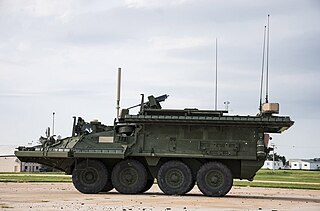
Iron Curtain was an active protection system (APS) created in 2005 and designed by Artis, an American technology development and manufacturing firm. The system deactivated threats, such as rocket-propelled grenades (RPG) and other shoulder-launched missiles.

The T-14Armata is a Russian main battle tank (MBT) based on the Armata Universal Combat Platform.

The T-15 Armata, with industrial designation "Object 149", is a Russian heavy infantry fighting vehicle first seen in public in 2015 during rehearsals for the Moscow Victory Day Parade. The T-15 concept of a heavy IFV is derived from design of the BTR-T vehicle that never entered military service. As of May 2023, the T-15 Armata has not entered service and the program status is unknown.
The Sarab Active Protection System (Mirage) is an active protection system, developed by the Syrian Scientific Studies and Research Center (CERS) and designed to help the Syrian Army’s T-55, T-62, and T-72 tanks counter line of sight anti-tank guided missiles (ATGMs).

KAPS is an active protection system developed by the Agency for Defense Development (ADD) and Hanwha Thales for K2 Black Panther in 2011. It was decided to introduce a hard-kill active protection system to strengthen the survival of South Korean main battle tanks (MBT), and the development was completed under the leadership of ADD from 2006 to December 2011.

The Panther KF51 is a German main battle tank (MBT) that is under development by Rheinmetall Landsysteme. It was unveiled publicly at the Eurosatory defence exhibition on 13 June 2022.
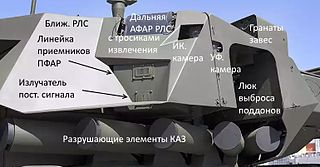
Afganit is a Russian active protection system (APS) employed on modern Russian Armata family of vehicles. It is intended to supersede the Arena APS and utilises radar and electro-optical sensors in the ultraviolet and infrared bands. The millimeter-wavelength radar detects and tracks incoming anti-tank munitions. The system can reportedly intercept armour-piercing fin-stabilized discarding sabot kinetic energy penetrators in addition to high-explosive anti-tank (HEAT) munitions. Currently, the maximum speed that can be intercepted is 1,700 m/s (Mach 5.0), with projected future increases of up to 3,000 m/s (Mach 8.8). According to news sources, it protects the tank from all sides.
















